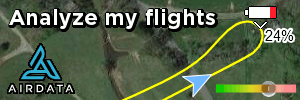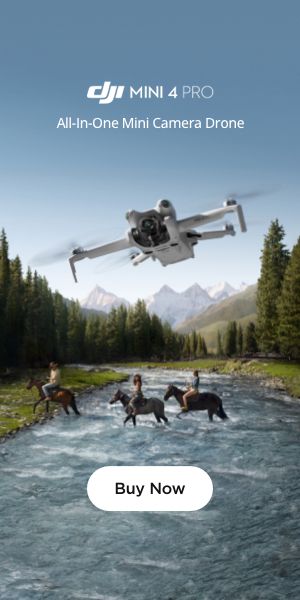You are using an out of date browser. It may not display this or other websites correctly.
You should upgrade or use an alternative browser.
You should upgrade or use an alternative browser.
Pilots Need to Stay the Hell Away from First-Responder Drones.
- Thread starter The Droning Company
- Start date
Good post, I'm going to mark this thread for later in the year when I can comment more accurately on these events. There is an active TFR and *all* drone pilots need to learn to check it for *every* flight and obey it, too. Pretty sure none of the consumer drones interfered with the Reaper but ordinary manned rescue aircraft and helicopters....for sure and it's still an issue, even after the events in NC/VA. So far I haven't heard of the details about the crash but hopefully we get more information on it later as well as the continuing rescue operations for this tragedy.
You can't legislate, teach, cajole, inform, preach to stupid people. Stupid is as stupid does. The idiots of the world are incorrigible. Catch them and make an example of them.
The title might be better if it started with the word “Drone”. It could also state that a
“All Pilots Should Brief TFRs and NOTAMs In Pre-Flight Planning”.
“All Pilots Should Brief TFRs and NOTAMs In Pre-Flight Planning”.
Volunteer drone operators could be force multiplier to search and rescue operations if there's a framework in which they can operate safely. It is time for first responder SAR personnel to come up with ideas in how sUAS, helicopters, and other airplanes can be integrated into the operations.
hank970
Well-Known Member
As one who sometimes relied on highly organized and well-trained volunteer groups to augment National Park Service personnel in wildland fire suppression and in searches and rescues or recoveries, I might agree with you. But, as always, the devil's in the details. Membership in volunteer groups has to be highly selective, training and equipment standards have to be formalized and adhered to, skills have to be practiced and demonstrated, communication protocols established, and so on. Further, how does a local volunteer group maintain member enthusiasm and dedication over time if it's never called out because applicable emergencies and opportunities to respond are few and far between?Volunteer drone operators could be force multiplier to search and rescue operations if there's a framework in which they can operate safely. It is time for first responder SAR personnel to come up with ideas in how sUAS, helicopters, and other airplanes can be integrated into the operations.
When compared with human and animal assets on the ground, consumer drones also have extremely limited endurance -- safely and reliably only thirty minutes or so of flight time per charge. Also limiting range in areas of high relief is the attenuation of control signals due to terrain. Of what benefit is a drone in a remote area which might encompass tens or hundreds of thousands of acres -- places where transit time to an area of interest would consume most of a battery charge?
We're not trying to fold amateur recreational untrained drone flyers and their consumer drones into a formal search and rescue process. Only asking for a minor exception to the process only in extreme times of emergency (maybe once or twice a decade) where it comes down to life or death for the victims. Is there no place for consumer drones at all?As one who sometimes relied on highly organized and well-trained volunteer groups to augment National Park Service personnel in wildland fire suppression and in searches and rescues or recoveries, I might agree with you. But, as always, the devil's in the details. Membership in volunteer groups has to be highly selective, training and equipment standards have to be formalized and adhered to, skills have to be practiced and demonstrated, communication protocols established, and so on. Further, how does a local volunteer group maintain member enthusiasm and dedication over time if it's never called out because applicable emergencies and opportunities to respond are few and far between?
When compared with human and animal assets on the ground, consumer drones also have extremely limited endurance -- safely and reliably only thirty minutes or so of flight time per charge. Also limiting range in areas of high relief is the attenuation of control signals due to terrain. Of what benefit is a drone in a remote area which might encompass tens or hundreds of thousands of acres -- places where transit time to an area of interest would consume most of a battery charge?
hank970
Well-Known Member
If you feel you're qualified, why not ask your local emergency services director (or the equivalent) and see what kind of response you get?We're not trying to fold amateur recreational untrained drone flyers and their consumer drones into a formal search and rescue process. Only asking for a minor exception to the process only in extreme times of emergency (maybe once or twice a decade) where it comes down to life or death for the victims. Is there no place for consumer drones at all?
I have to be "qualified" to fly a drone and rescue my family in a dire emergency? Since when?If you feel you're qualified, why not ask your local emergency services director (or the equivalent) and see what kind of response you get?
This isn't about me, I'd just like to hear your opinion if you care to share it please. Otherwise, no problem.
hank970
Well-Known Member
I'm not familiar with your drone skills or motivations or of your family's potential exposure to risk.
When I suggested that you contact your local emergency services people, it was so you could determine how receptive they might be to the formation of a competent volunteer drone organization. They're probably not familiar with your skills and qualifications either. I can assure you they wouldn't want a bunch of freelancers and wannabe heroes getting in the way of an emergency operation. If you or anyone else wants a "minor exception," to fly your drones during an emergency, you're probably going to have to earn their trust first. You don't need to convince me; you'd need to convince them.
That said, qualified or not, I'd imagine that flying a drone when or if your family is faced with a dire (your word) emergency is the last thing you'd want to do. But illuminate me. How do you think flying a drone in the face of or in the aftermath of a flash flood or wildlands fire or hurricane might help your family?
I've seen and heard a lot of survivors interviewed on TV in the wake of disasters. Never have I heard any of them say, "If only I had flown my drone."
When I suggested that you contact your local emergency services people, it was so you could determine how receptive they might be to the formation of a competent volunteer drone organization. They're probably not familiar with your skills and qualifications either. I can assure you they wouldn't want a bunch of freelancers and wannabe heroes getting in the way of an emergency operation. If you or anyone else wants a "minor exception," to fly your drones during an emergency, you're probably going to have to earn their trust first. You don't need to convince me; you'd need to convince them.
That said, qualified or not, I'd imagine that flying a drone when or if your family is faced with a dire (your word) emergency is the last thing you'd want to do. But illuminate me. How do you think flying a drone in the face of or in the aftermath of a flash flood or wildlands fire or hurricane might help your family?
I've seen and heard a lot of survivors interviewed on TV in the wake of disasters. Never have I heard any of them say, "If only I had flown my drone."
Short answer is since there is a TFR posted. The level of coordination in airspace and comms for a big SAR op is astounding. The last thing you want to be doing is flying your drone in airspace for which others have been given clearance and responsibility. With all the Coast Guard and National Guard helos scouring the area at relatively low altitude and with a reasonably fast ground track, the probability that your drone could be in the way, especially if you are looking at your screen to find folks, is relatively high. If caught, your fines will be high. If your drone impacts an authorized aircraft, your liability will likely cost you everything and likely jail time.I have to be "qualified" to fly a drone and rescue my family in a dire emergency? Since when?
Last edited:
Most of us don’t want to be this guy, but you do you…

 www.click2houston.com
www.click2houston.com

‘Entirely preventable’: Drone collides with rescue helicopter during Kerr County flood search efforts
A privately operated drone collided with a rescue helicopter in Kerr County during ongoing flood recovery efforts, necessitating an emergency landing and risking the safety of first responders.
Similar threads
- Replies
- 1
- Views
- 306
- Replies
- 17
- Views
- 960
- Replies
- 10
- Views
- 569
- Replies
- 4
- Views
- 632
DJI Drone Deals
New Threads
-
-
-
-
Mini 4 Pro Some incredible views from a ride in East Java, Indonesia!
- Started by rohmattullah
- Replies: 0
-










